Business Law: Rules of Offer, Counter Offer and Consideration
VerifiedAdded on 2023/06/10
|8
|1904
|162
AI Summary
This article discusses the rules of offer, counter offer and consideration in business law with the help of solved case studies. It covers the principles established in various cases such as Hyde v Wrench, Stevenson, Jaques & Co. v McLean, Currie v Misa, Stilk v Myrrick, Hartley v Ponsonby, and more. The article also explains the exceptions to the rules and their application in different scenarios.
Contribute Materials
Your contribution can guide someone’s learning journey. Share your
documents today.
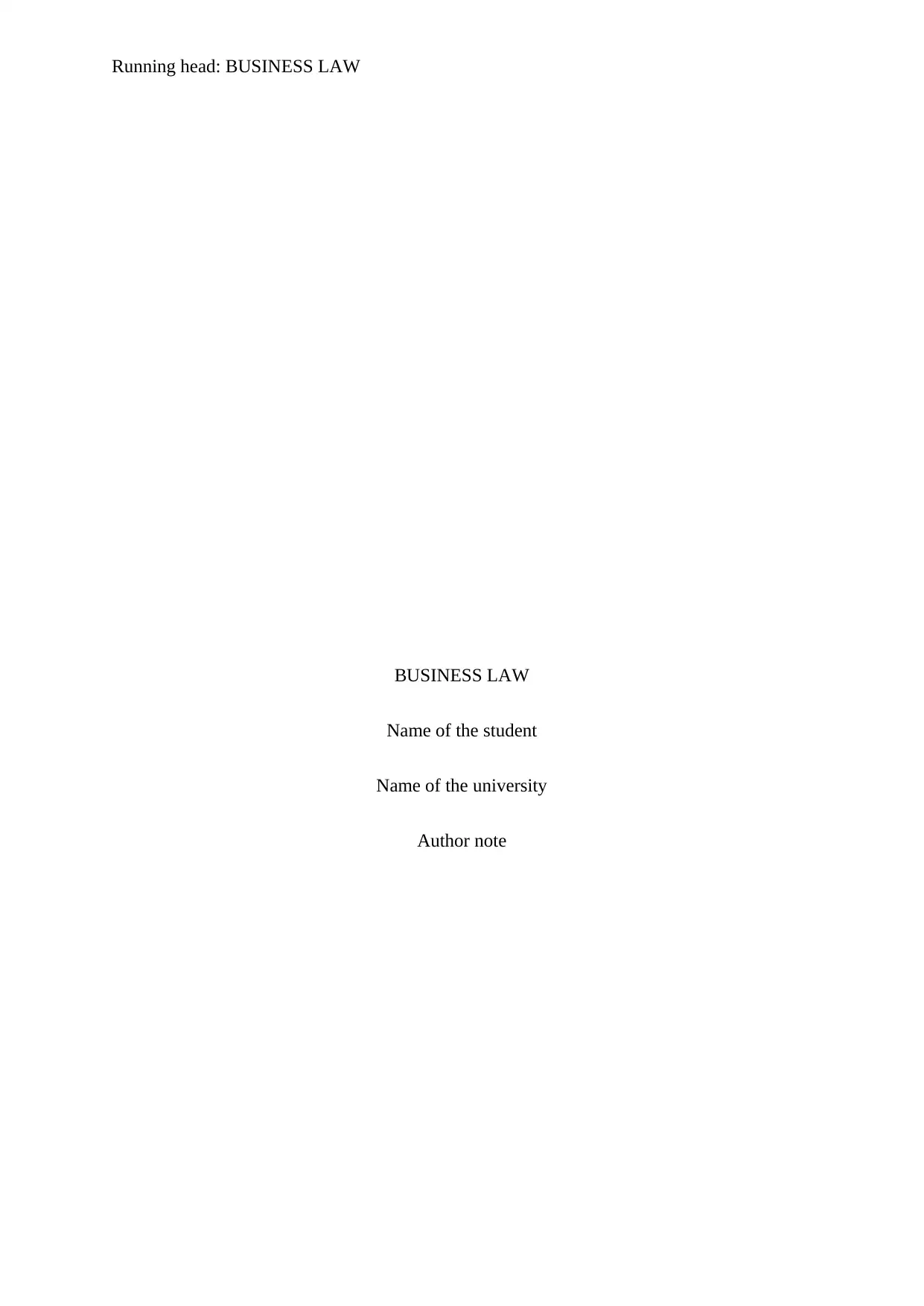
Running head: BUSINESS LAW
BUSINESS LAW
Name of the student
Name of the university
Author note
BUSINESS LAW
Name of the student
Name of the university
Author note
Secure Best Marks with AI Grader
Need help grading? Try our AI Grader for instant feedback on your assignments.
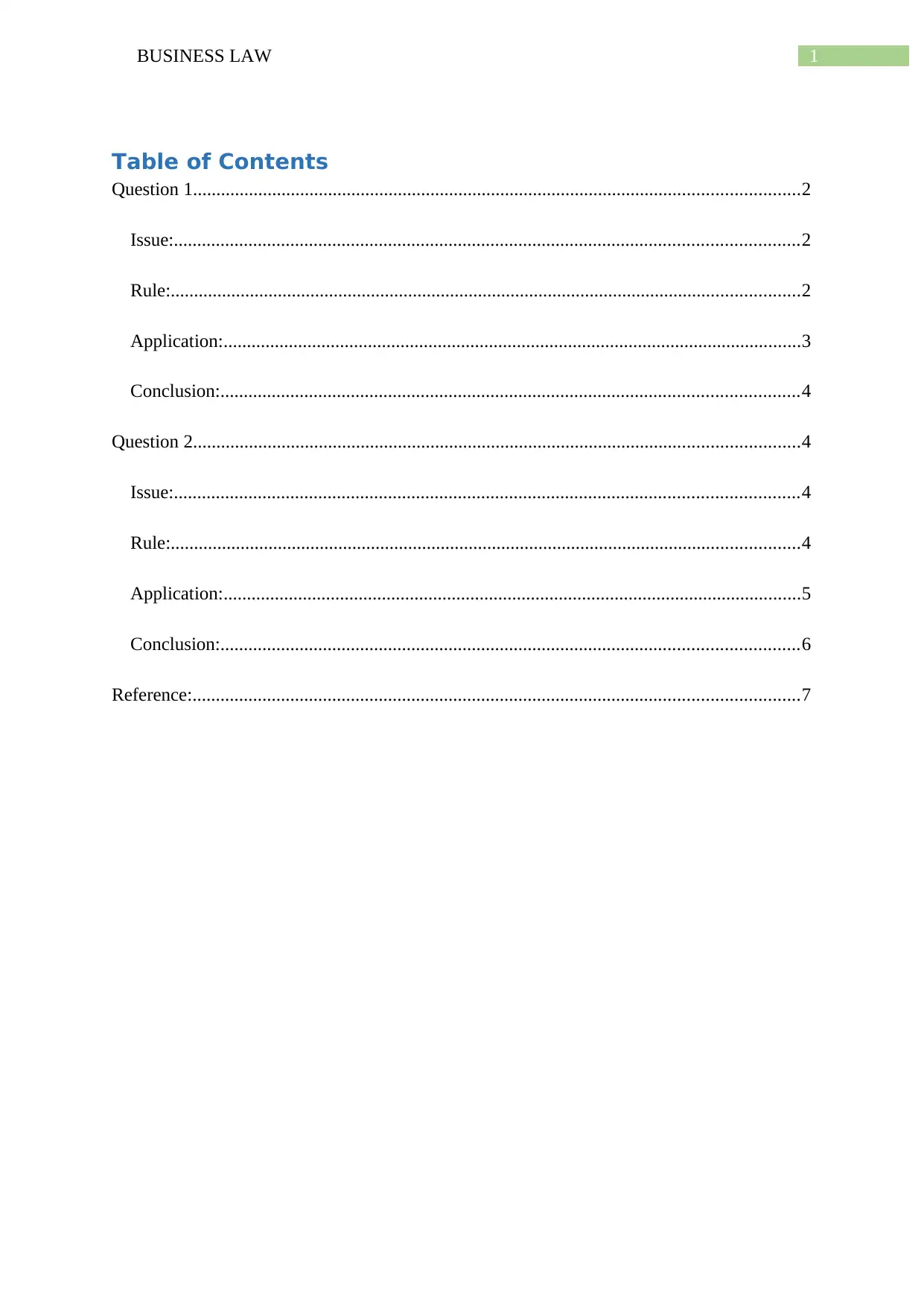
1BUSINESS LAW
Table of Contents
Question 1..................................................................................................................................2
Issue:......................................................................................................................................2
Rule:.......................................................................................................................................2
Application:............................................................................................................................3
Conclusion:............................................................................................................................4
Question 2..................................................................................................................................4
Issue:......................................................................................................................................4
Rule:.......................................................................................................................................4
Application:............................................................................................................................5
Conclusion:............................................................................................................................6
Reference:..................................................................................................................................7
Table of Contents
Question 1..................................................................................................................................2
Issue:......................................................................................................................................2
Rule:.......................................................................................................................................2
Application:............................................................................................................................3
Conclusion:............................................................................................................................4
Question 2..................................................................................................................................4
Issue:......................................................................................................................................4
Rule:.......................................................................................................................................4
Application:............................................................................................................................5
Conclusion:............................................................................................................................6
Reference:..................................................................................................................................7
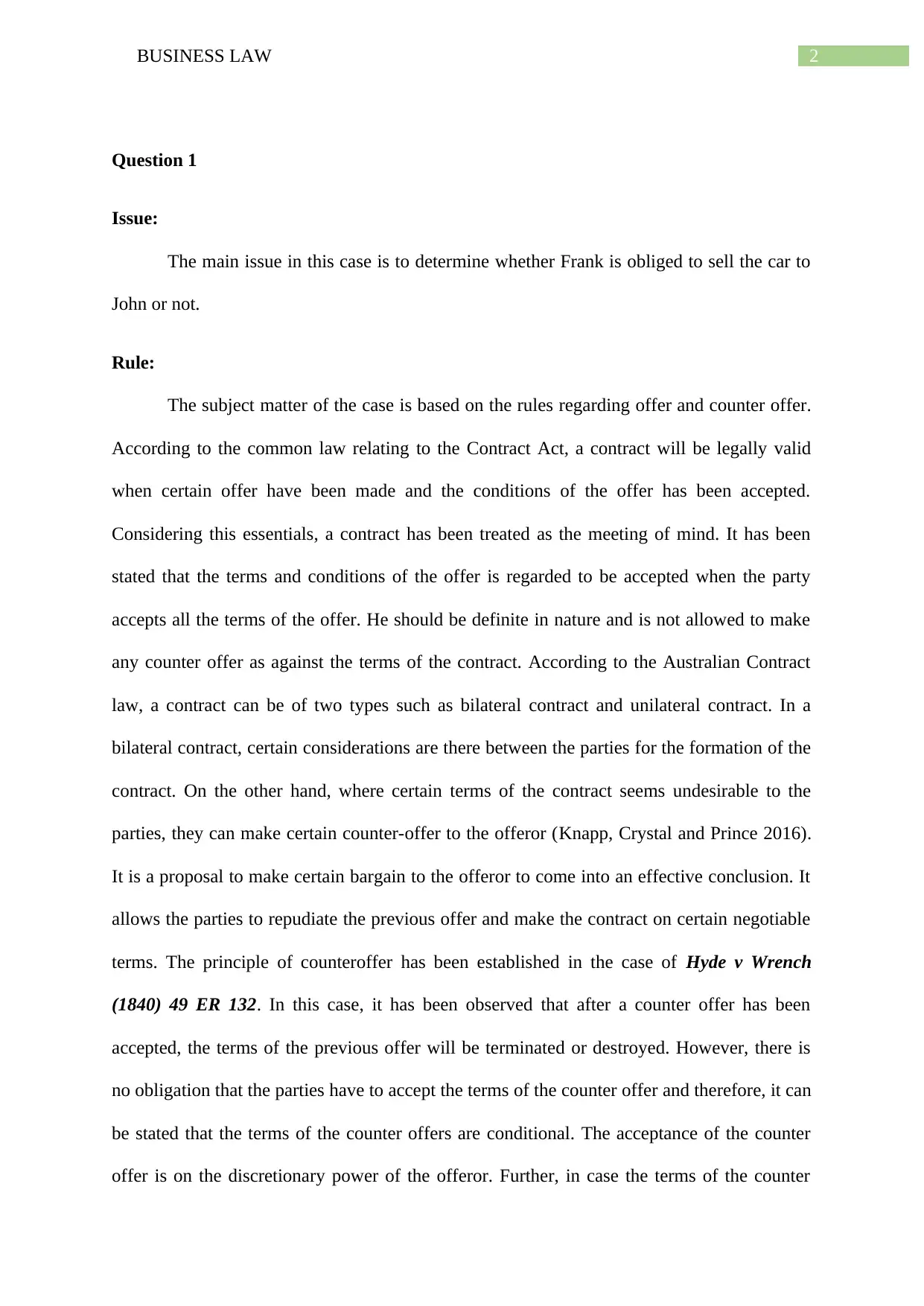
2BUSINESS LAW
Question 1
Issue:
The main issue in this case is to determine whether Frank is obliged to sell the car to
John or not.
Rule:
The subject matter of the case is based on the rules regarding offer and counter offer.
According to the common law relating to the Contract Act, a contract will be legally valid
when certain offer have been made and the conditions of the offer has been accepted.
Considering this essentials, a contract has been treated as the meeting of mind. It has been
stated that the terms and conditions of the offer is regarded to be accepted when the party
accepts all the terms of the offer. He should be definite in nature and is not allowed to make
any counter offer as against the terms of the contract. According to the Australian Contract
law, a contract can be of two types such as bilateral contract and unilateral contract. In a
bilateral contract, certain considerations are there between the parties for the formation of the
contract. On the other hand, where certain terms of the contract seems undesirable to the
parties, they can make certain counter-offer to the offeror (Knapp, Crystal and Prince 2016).
It is a proposal to make certain bargain to the offeror to come into an effective conclusion. It
allows the parties to repudiate the previous offer and make the contract on certain negotiable
terms. The principle of counteroffer has been established in the case of Hyde v Wrench
(1840) 49 ER 132. In this case, it has been observed that after a counter offer has been
accepted, the terms of the previous offer will be terminated or destroyed. However, there is
no obligation that the parties have to accept the terms of the counter offer and therefore, it can
be stated that the terms of the counter offers are conditional. The acceptance of the counter
offer is on the discretionary power of the offeror. Further, in case the terms of the counter
Question 1
Issue:
The main issue in this case is to determine whether Frank is obliged to sell the car to
John or not.
Rule:
The subject matter of the case is based on the rules regarding offer and counter offer.
According to the common law relating to the Contract Act, a contract will be legally valid
when certain offer have been made and the conditions of the offer has been accepted.
Considering this essentials, a contract has been treated as the meeting of mind. It has been
stated that the terms and conditions of the offer is regarded to be accepted when the party
accepts all the terms of the offer. He should be definite in nature and is not allowed to make
any counter offer as against the terms of the contract. According to the Australian Contract
law, a contract can be of two types such as bilateral contract and unilateral contract. In a
bilateral contract, certain considerations are there between the parties for the formation of the
contract. On the other hand, where certain terms of the contract seems undesirable to the
parties, they can make certain counter-offer to the offeror (Knapp, Crystal and Prince 2016).
It is a proposal to make certain bargain to the offeror to come into an effective conclusion. It
allows the parties to repudiate the previous offer and make the contract on certain negotiable
terms. The principle of counteroffer has been established in the case of Hyde v Wrench
(1840) 49 ER 132. In this case, it has been observed that after a counter offer has been
accepted, the terms of the previous offer will be terminated or destroyed. However, there is
no obligation that the parties have to accept the terms of the counter offer and therefore, it can
be stated that the terms of the counter offers are conditional. The acceptance of the counter
offer is on the discretionary power of the offeror. Further, in case the terms of the counter
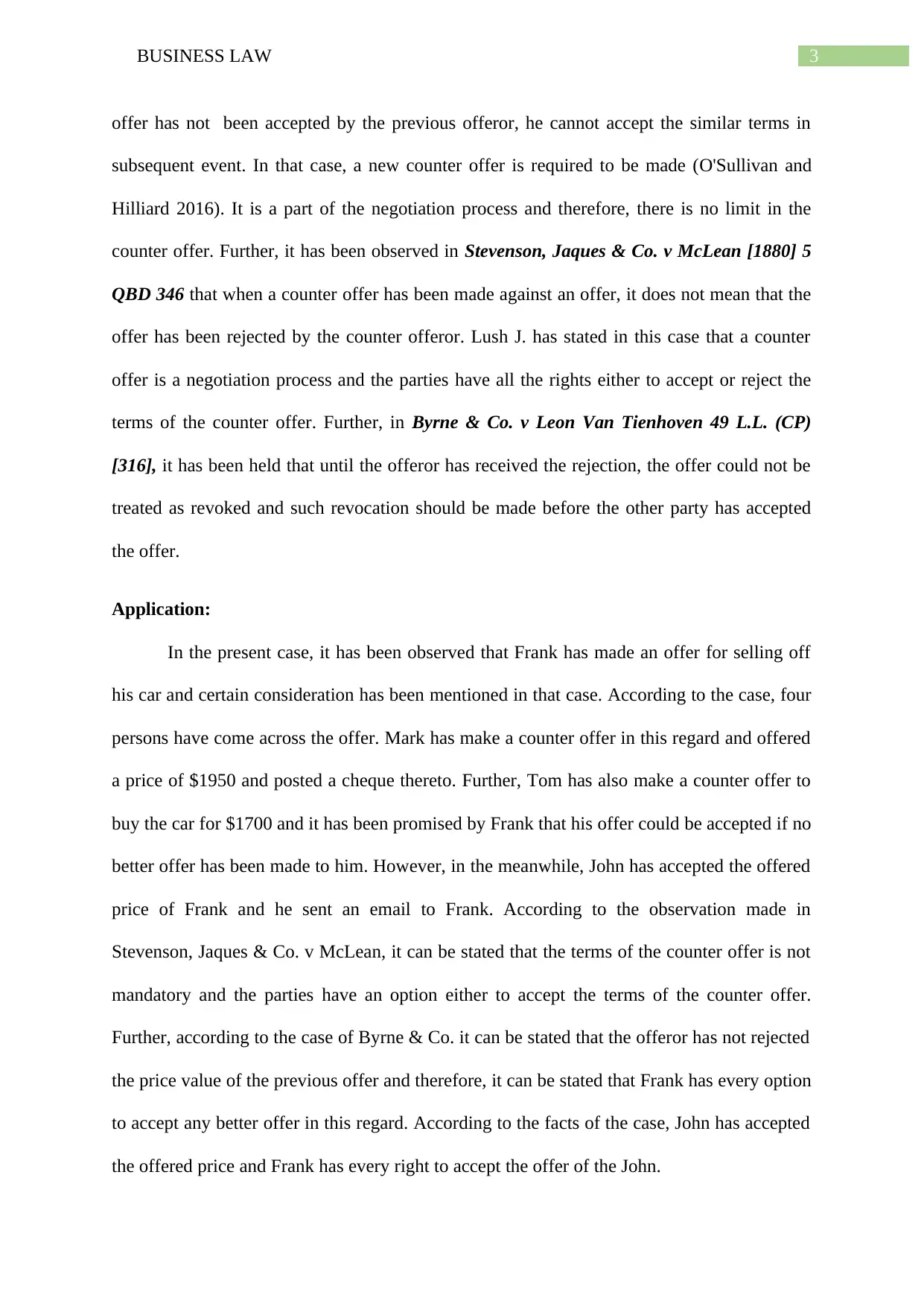
3BUSINESS LAW
offer has not been accepted by the previous offeror, he cannot accept the similar terms in
subsequent event. In that case, a new counter offer is required to be made (O'Sullivan and
Hilliard 2016). It is a part of the negotiation process and therefore, there is no limit in the
counter offer. Further, it has been observed in Stevenson, Jaques & Co. v McLean [1880] 5
QBD 346 that when a counter offer has been made against an offer, it does not mean that the
offer has been rejected by the counter offeror. Lush J. has stated in this case that a counter
offer is a negotiation process and the parties have all the rights either to accept or reject the
terms of the counter offer. Further, in Byrne & Co. v Leon Van Tienhoven 49 L.L. (CP)
[316], it has been held that until the offeror has received the rejection, the offer could not be
treated as revoked and such revocation should be made before the other party has accepted
the offer.
Application:
In the present case, it has been observed that Frank has made an offer for selling off
his car and certain consideration has been mentioned in that case. According to the case, four
persons have come across the offer. Mark has make a counter offer in this regard and offered
a price of $1950 and posted a cheque thereto. Further, Tom has also make a counter offer to
buy the car for $1700 and it has been promised by Frank that his offer could be accepted if no
better offer has been made to him. However, in the meanwhile, John has accepted the offered
price of Frank and he sent an email to Frank. According to the observation made in
Stevenson, Jaques & Co. v McLean, it can be stated that the terms of the counter offer is not
mandatory and the parties have an option either to accept the terms of the counter offer.
Further, according to the case of Byrne & Co. it can be stated that the offeror has not rejected
the price value of the previous offer and therefore, it can be stated that Frank has every option
to accept any better offer in this regard. According to the facts of the case, John has accepted
the offered price and Frank has every right to accept the offer of the John.
offer has not been accepted by the previous offeror, he cannot accept the similar terms in
subsequent event. In that case, a new counter offer is required to be made (O'Sullivan and
Hilliard 2016). It is a part of the negotiation process and therefore, there is no limit in the
counter offer. Further, it has been observed in Stevenson, Jaques & Co. v McLean [1880] 5
QBD 346 that when a counter offer has been made against an offer, it does not mean that the
offer has been rejected by the counter offeror. Lush J. has stated in this case that a counter
offer is a negotiation process and the parties have all the rights either to accept or reject the
terms of the counter offer. Further, in Byrne & Co. v Leon Van Tienhoven 49 L.L. (CP)
[316], it has been held that until the offeror has received the rejection, the offer could not be
treated as revoked and such revocation should be made before the other party has accepted
the offer.
Application:
In the present case, it has been observed that Frank has made an offer for selling off
his car and certain consideration has been mentioned in that case. According to the case, four
persons have come across the offer. Mark has make a counter offer in this regard and offered
a price of $1950 and posted a cheque thereto. Further, Tom has also make a counter offer to
buy the car for $1700 and it has been promised by Frank that his offer could be accepted if no
better offer has been made to him. However, in the meanwhile, John has accepted the offered
price of Frank and he sent an email to Frank. According to the observation made in
Stevenson, Jaques & Co. v McLean, it can be stated that the terms of the counter offer is not
mandatory and the parties have an option either to accept the terms of the counter offer.
Further, according to the case of Byrne & Co. it can be stated that the offeror has not rejected
the price value of the previous offer and therefore, it can be stated that Frank has every option
to accept any better offer in this regard. According to the facts of the case, John has accepted
the offered price and Frank has every right to accept the offer of the John.
Secure Best Marks with AI Grader
Need help grading? Try our AI Grader for instant feedback on your assignments.
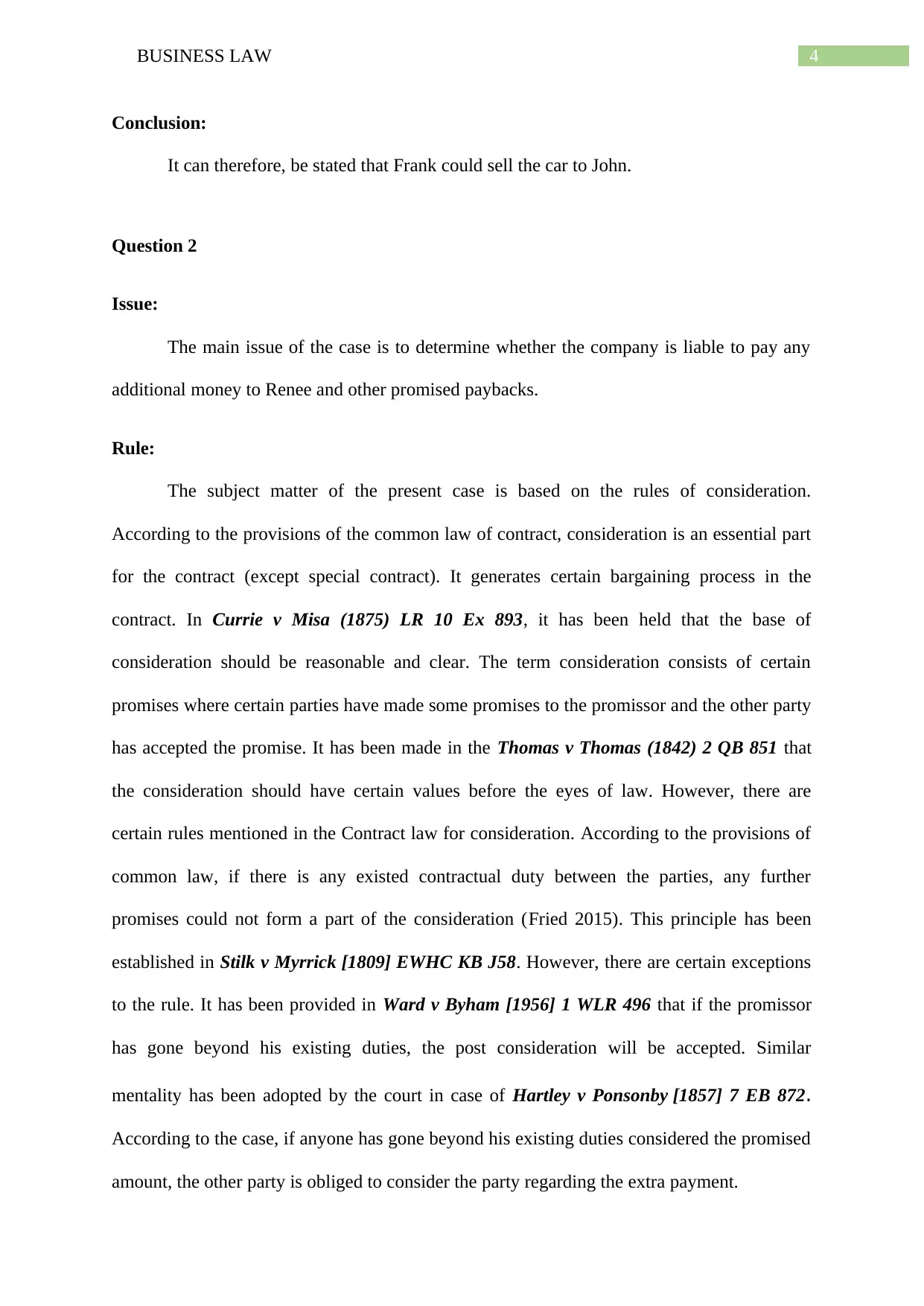
4BUSINESS LAW
Conclusion:
It can therefore, be stated that Frank could sell the car to John.
Question 2
Issue:
The main issue of the case is to determine whether the company is liable to pay any
additional money to Renee and other promised paybacks.
Rule:
The subject matter of the present case is based on the rules of consideration.
According to the provisions of the common law of contract, consideration is an essential part
for the contract (except special contract). It generates certain bargaining process in the
contract. In Currie v Misa (1875) LR 10 Ex 893, it has been held that the base of
consideration should be reasonable and clear. The term consideration consists of certain
promises where certain parties have made some promises to the promissor and the other party
has accepted the promise. It has been made in the Thomas v Thomas (1842) 2 QB 851 that
the consideration should have certain values before the eyes of law. However, there are
certain rules mentioned in the Contract law for consideration. According to the provisions of
common law, if there is any existed contractual duty between the parties, any further
promises could not form a part of the consideration (Fried 2015). This principle has been
established in Stilk v Myrrick [1809] EWHC KB J58. However, there are certain exceptions
to the rule. It has been provided in Ward v Byham [1956] 1 WLR 496 that if the promissor
has gone beyond his existing duties, the post consideration will be accepted. Similar
mentality has been adopted by the court in case of Hartley v Ponsonby [1857] 7 EB 872.
According to the case, if anyone has gone beyond his existing duties considered the promised
amount, the other party is obliged to consider the party regarding the extra payment.
Conclusion:
It can therefore, be stated that Frank could sell the car to John.
Question 2
Issue:
The main issue of the case is to determine whether the company is liable to pay any
additional money to Renee and other promised paybacks.
Rule:
The subject matter of the present case is based on the rules of consideration.
According to the provisions of the common law of contract, consideration is an essential part
for the contract (except special contract). It generates certain bargaining process in the
contract. In Currie v Misa (1875) LR 10 Ex 893, it has been held that the base of
consideration should be reasonable and clear. The term consideration consists of certain
promises where certain parties have made some promises to the promissor and the other party
has accepted the promise. It has been made in the Thomas v Thomas (1842) 2 QB 851 that
the consideration should have certain values before the eyes of law. However, there are
certain rules mentioned in the Contract law for consideration. According to the provisions of
common law, if there is any existed contractual duty between the parties, any further
promises could not form a part of the consideration (Fried 2015). This principle has been
established in Stilk v Myrrick [1809] EWHC KB J58. However, there are certain exceptions
to the rule. It has been provided in Ward v Byham [1956] 1 WLR 496 that if the promissor
has gone beyond his existing duties, the post consideration will be accepted. Similar
mentality has been adopted by the court in case of Hartley v Ponsonby [1857] 7 EB 872.
According to the case, if anyone has gone beyond his existing duties considered the promised
amount, the other party is obliged to consider the party regarding the extra payment.
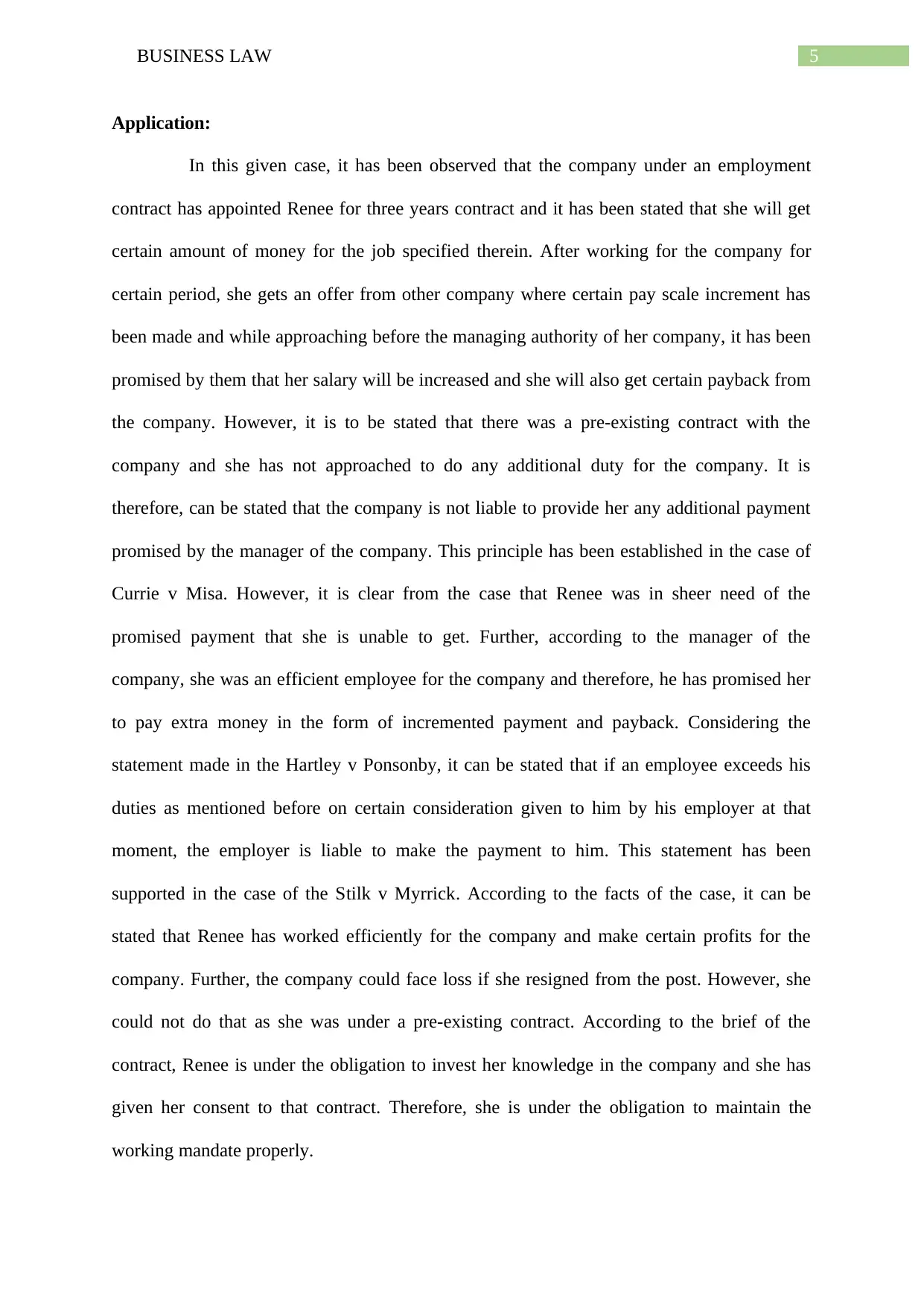
5BUSINESS LAW
Application:
In this given case, it has been observed that the company under an employment
contract has appointed Renee for three years contract and it has been stated that she will get
certain amount of money for the job specified therein. After working for the company for
certain period, she gets an offer from other company where certain pay scale increment has
been made and while approaching before the managing authority of her company, it has been
promised by them that her salary will be increased and she will also get certain payback from
the company. However, it is to be stated that there was a pre-existing contract with the
company and she has not approached to do any additional duty for the company. It is
therefore, can be stated that the company is not liable to provide her any additional payment
promised by the manager of the company. This principle has been established in the case of
Currie v Misa. However, it is clear from the case that Renee was in sheer need of the
promised payment that she is unable to get. Further, according to the manager of the
company, she was an efficient employee for the company and therefore, he has promised her
to pay extra money in the form of incremented payment and payback. Considering the
statement made in the Hartley v Ponsonby, it can be stated that if an employee exceeds his
duties as mentioned before on certain consideration given to him by his employer at that
moment, the employer is liable to make the payment to him. This statement has been
supported in the case of the Stilk v Myrrick. According to the facts of the case, it can be
stated that Renee has worked efficiently for the company and make certain profits for the
company. Further, the company could face loss if she resigned from the post. However, she
could not do that as she was under a pre-existing contract. According to the brief of the
contract, Renee is under the obligation to invest her knowledge in the company and she has
given her consent to that contract. Therefore, she is under the obligation to maintain the
working mandate properly.
Application:
In this given case, it has been observed that the company under an employment
contract has appointed Renee for three years contract and it has been stated that she will get
certain amount of money for the job specified therein. After working for the company for
certain period, she gets an offer from other company where certain pay scale increment has
been made and while approaching before the managing authority of her company, it has been
promised by them that her salary will be increased and she will also get certain payback from
the company. However, it is to be stated that there was a pre-existing contract with the
company and she has not approached to do any additional duty for the company. It is
therefore, can be stated that the company is not liable to provide her any additional payment
promised by the manager of the company. This principle has been established in the case of
Currie v Misa. However, it is clear from the case that Renee was in sheer need of the
promised payment that she is unable to get. Further, according to the manager of the
company, she was an efficient employee for the company and therefore, he has promised her
to pay extra money in the form of incremented payment and payback. Considering the
statement made in the Hartley v Ponsonby, it can be stated that if an employee exceeds his
duties as mentioned before on certain consideration given to him by his employer at that
moment, the employer is liable to make the payment to him. This statement has been
supported in the case of the Stilk v Myrrick. According to the facts of the case, it can be
stated that Renee has worked efficiently for the company and make certain profits for the
company. Further, the company could face loss if she resigned from the post. However, she
could not do that as she was under a pre-existing contract. According to the brief of the
contract, Renee is under the obligation to invest her knowledge in the company and she has
given her consent to that contract. Therefore, she is under the obligation to maintain the
working mandate properly.
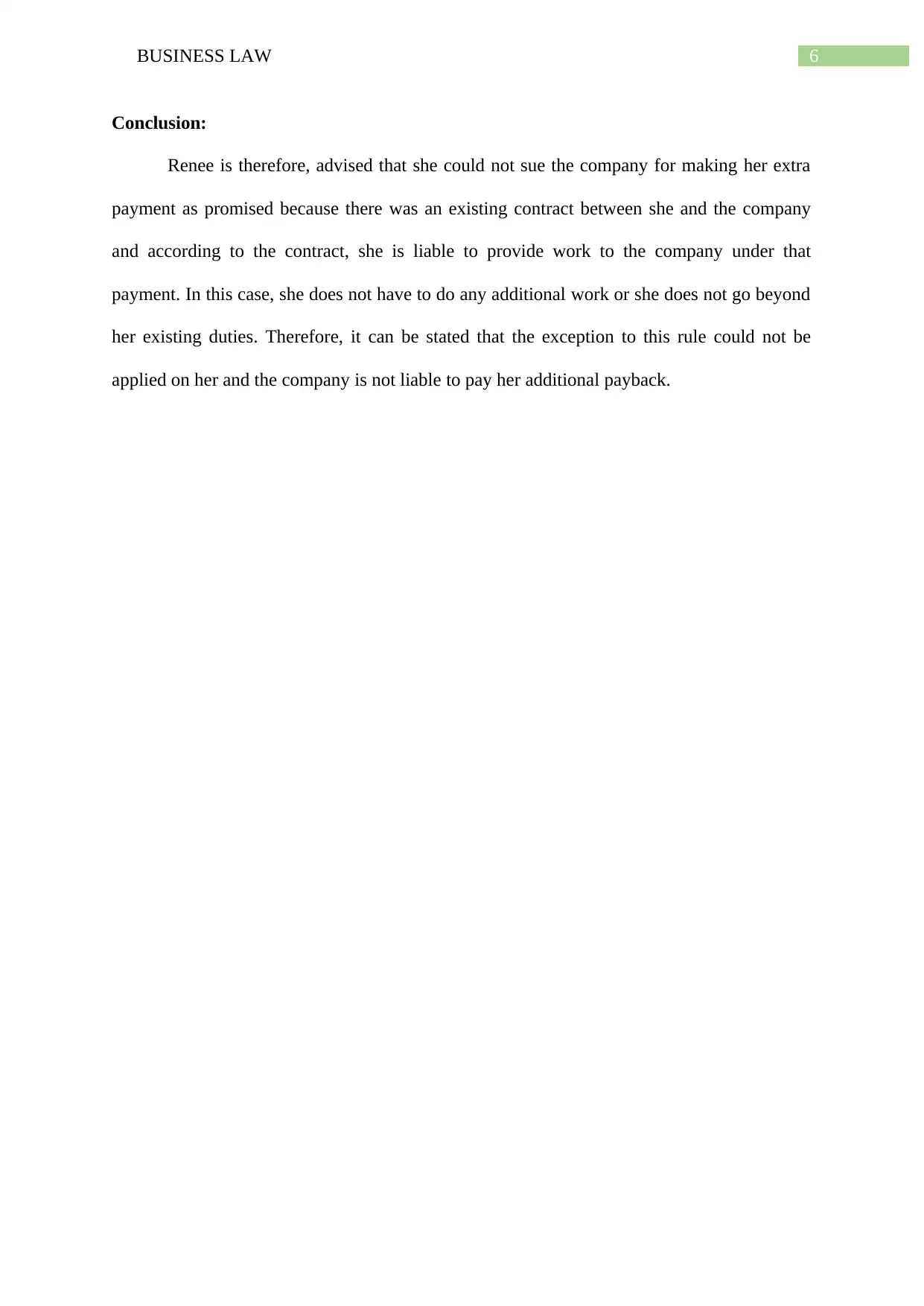
6BUSINESS LAW
Conclusion:
Renee is therefore, advised that she could not sue the company for making her extra
payment as promised because there was an existing contract between she and the company
and according to the contract, she is liable to provide work to the company under that
payment. In this case, she does not have to do any additional work or she does not go beyond
her existing duties. Therefore, it can be stated that the exception to this rule could not be
applied on her and the company is not liable to pay her additional payback.
Conclusion:
Renee is therefore, advised that she could not sue the company for making her extra
payment as promised because there was an existing contract between she and the company
and according to the contract, she is liable to provide work to the company under that
payment. In this case, she does not have to do any additional work or she does not go beyond
her existing duties. Therefore, it can be stated that the exception to this rule could not be
applied on her and the company is not liable to pay her additional payback.
Paraphrase This Document
Need a fresh take? Get an instant paraphrase of this document with our AI Paraphraser
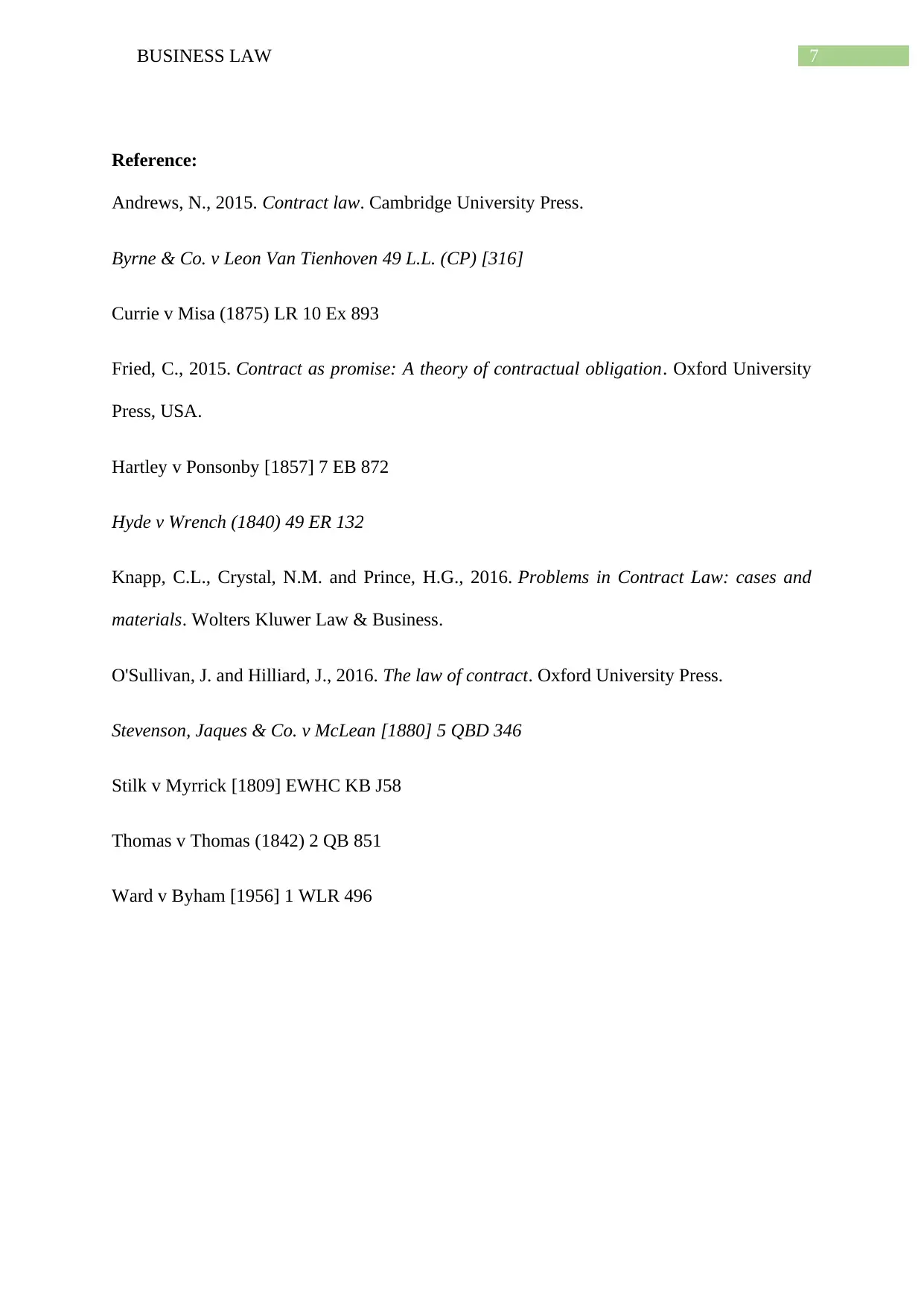
7BUSINESS LAW
Reference:
Andrews, N., 2015. Contract law. Cambridge University Press.
Byrne & Co. v Leon Van Tienhoven 49 L.L. (CP) [316]
Currie v Misa (1875) LR 10 Ex 893
Fried, C., 2015. Contract as promise: A theory of contractual obligation. Oxford University
Press, USA.
Hartley v Ponsonby [1857] 7 EB 872
Hyde v Wrench (1840) 49 ER 132
Knapp, C.L., Crystal, N.M. and Prince, H.G., 2016. Problems in Contract Law: cases and
materials. Wolters Kluwer Law & Business.
O'Sullivan, J. and Hilliard, J., 2016. The law of contract. Oxford University Press.
Stevenson, Jaques & Co. v McLean [1880] 5 QBD 346
Stilk v Myrrick [1809] EWHC KB J58
Thomas v Thomas (1842) 2 QB 851
Ward v Byham [1956] 1 WLR 496
Reference:
Andrews, N., 2015. Contract law. Cambridge University Press.
Byrne & Co. v Leon Van Tienhoven 49 L.L. (CP) [316]
Currie v Misa (1875) LR 10 Ex 893
Fried, C., 2015. Contract as promise: A theory of contractual obligation. Oxford University
Press, USA.
Hartley v Ponsonby [1857] 7 EB 872
Hyde v Wrench (1840) 49 ER 132
Knapp, C.L., Crystal, N.M. and Prince, H.G., 2016. Problems in Contract Law: cases and
materials. Wolters Kluwer Law & Business.
O'Sullivan, J. and Hilliard, J., 2016. The law of contract. Oxford University Press.
Stevenson, Jaques & Co. v McLean [1880] 5 QBD 346
Stilk v Myrrick [1809] EWHC KB J58
Thomas v Thomas (1842) 2 QB 851
Ward v Byham [1956] 1 WLR 496
1 out of 8
Related Documents
Your All-in-One AI-Powered Toolkit for Academic Success.
+13062052269
info@desklib.com
Available 24*7 on WhatsApp / Email
![[object Object]](/_next/static/media/star-bottom.7253800d.svg)
Unlock your academic potential
© 2024 | Zucol Services PVT LTD | All rights reserved.




